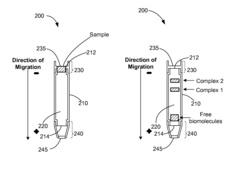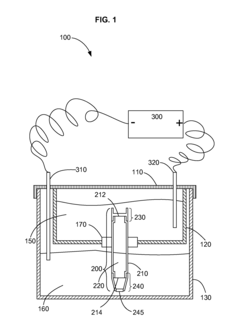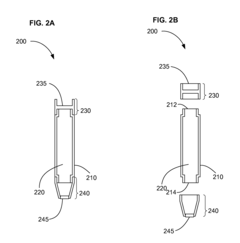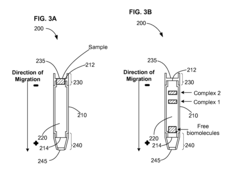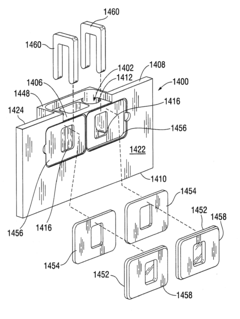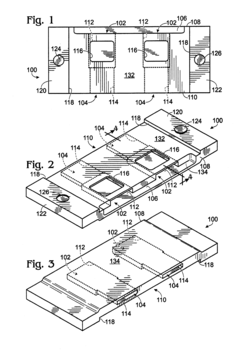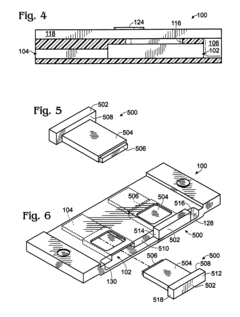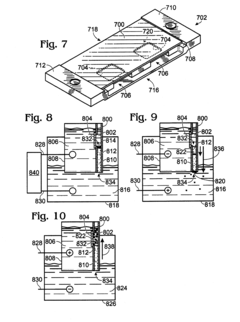Gel Electrophoresis and Its Role in Synthetic Biology
JUN 30, 20259 MIN READ
Generate Your Research Report Instantly with AI Agent
Patsnap Eureka helps you evaluate technical feasibility & market potential.
Gel Electrophoresis Evolution and Objectives
Gel electrophoresis has been a cornerstone technique in molecular biology since its inception in the 1960s. This method, which separates molecules based on their size and electrical charge, has undergone significant evolution over the decades. Initially developed for protein analysis, it quickly found applications in DNA and RNA separation, becoming an indispensable tool in genetic research and diagnostics.
The evolution of gel electrophoresis has been marked by several key advancements. The introduction of agarose gels in the 1970s revolutionized DNA analysis, allowing for better resolution of larger molecules. Polyacrylamide gels, with their finer pore size, enhanced the separation of smaller DNA fragments and proteins. The development of pulsed-field gel electrophoresis in the 1980s further expanded the technique's capabilities, enabling the separation of much larger DNA molecules.
In recent years, the integration of gel electrophoresis with other technologies has led to more sophisticated applications. Capillary electrophoresis, for instance, has improved automation and resolution. The advent of microfluidic devices has miniaturized the process, allowing for faster and more efficient separations with minimal sample volumes.
The objectives of gel electrophoresis in synthetic biology are multifaceted. Primarily, it serves as a crucial analytical tool for verifying the success of DNA manipulations, such as cloning, PCR amplification, and restriction digests. It allows researchers to visualize and isolate specific DNA fragments, essential for constructing synthetic genetic circuits and assembling artificial genomes.
Moreover, gel electrophoresis plays a vital role in quality control processes within synthetic biology. It helps in assessing the purity and integrity of synthesized DNA constructs, ensuring that the building blocks of synthetic biological systems are accurate and reliable. This is particularly important in the development of standardized biological parts, a key concept in synthetic biology.
The technique also facilitates the characterization of engineered biological systems. By analyzing the expression products of synthetic genes, researchers can evaluate the performance and efficiency of their designs. This feedback is crucial for iterative improvement of synthetic biological constructs.
Looking forward, the objectives for gel electrophoresis in synthetic biology include enhancing its speed, sensitivity, and integration with other analytical methods. There is a push towards developing real-time, in-process monitoring systems that can provide immediate feedback during synthetic biology workflows. Additionally, efforts are being made to improve the technique's ability to handle complex mixtures of biological molecules, addressing the increasing complexity of synthetic biological systems.
The evolution of gel electrophoresis has been marked by several key advancements. The introduction of agarose gels in the 1970s revolutionized DNA analysis, allowing for better resolution of larger molecules. Polyacrylamide gels, with their finer pore size, enhanced the separation of smaller DNA fragments and proteins. The development of pulsed-field gel electrophoresis in the 1980s further expanded the technique's capabilities, enabling the separation of much larger DNA molecules.
In recent years, the integration of gel electrophoresis with other technologies has led to more sophisticated applications. Capillary electrophoresis, for instance, has improved automation and resolution. The advent of microfluidic devices has miniaturized the process, allowing for faster and more efficient separations with minimal sample volumes.
The objectives of gel electrophoresis in synthetic biology are multifaceted. Primarily, it serves as a crucial analytical tool for verifying the success of DNA manipulations, such as cloning, PCR amplification, and restriction digests. It allows researchers to visualize and isolate specific DNA fragments, essential for constructing synthetic genetic circuits and assembling artificial genomes.
Moreover, gel electrophoresis plays a vital role in quality control processes within synthetic biology. It helps in assessing the purity and integrity of synthesized DNA constructs, ensuring that the building blocks of synthetic biological systems are accurate and reliable. This is particularly important in the development of standardized biological parts, a key concept in synthetic biology.
The technique also facilitates the characterization of engineered biological systems. By analyzing the expression products of synthetic genes, researchers can evaluate the performance and efficiency of their designs. This feedback is crucial for iterative improvement of synthetic biological constructs.
Looking forward, the objectives for gel electrophoresis in synthetic biology include enhancing its speed, sensitivity, and integration with other analytical methods. There is a push towards developing real-time, in-process monitoring systems that can provide immediate feedback during synthetic biology workflows. Additionally, efforts are being made to improve the technique's ability to handle complex mixtures of biological molecules, addressing the increasing complexity of synthetic biological systems.
Synthetic Biology Market Demand Analysis
The synthetic biology market has been experiencing significant growth and demand in recent years, driven by advancements in biotechnology, increasing research and development activities, and the expanding applications of synthetic biology across various industries. This market demand analysis focuses on the role of gel electrophoresis within the broader context of synthetic biology.
Gel electrophoresis, a fundamental technique in molecular biology, plays a crucial role in synthetic biology applications. As synthetic biology continues to evolve and expand, the demand for gel electrophoresis equipment, reagents, and related products has seen a corresponding increase. The market for gel electrophoresis within synthetic biology is expected to grow steadily due to its essential role in DNA and protein analysis, which are core components of synthetic biology research and development.
The pharmaceutical and biotechnology industries are major drivers of demand for synthetic biology tools, including gel electrophoresis. These sectors utilize synthetic biology techniques for drug discovery, development of biopharmaceuticals, and production of novel therapeutic compounds. As a result, the demand for reliable and efficient gel electrophoresis systems has risen to support these research efforts.
Academic and research institutions also contribute significantly to the market demand for gel electrophoresis in synthetic biology. Universities, government laboratories, and private research organizations are actively engaged in synthetic biology research, driving the need for advanced gel electrophoresis technologies to analyze and characterize synthetic DNA constructs and engineered proteins.
The agricultural sector is another key area driving demand for synthetic biology tools, including gel electrophoresis. Researchers are using synthetic biology approaches to develop genetically modified crops with improved traits, such as increased yield, disease resistance, and enhanced nutritional content. Gel electrophoresis is essential in these applications for verifying genetic modifications and analyzing protein expression.
Environmental and industrial biotechnology applications are also contributing to the growing demand for gel electrophoresis in synthetic biology. These fields utilize synthetic biology techniques to develop bioremediation solutions, produce biofuels, and create novel biomaterials. Gel electrophoresis is crucial for analyzing and optimizing the engineered microorganisms and enzymes used in these processes.
As the synthetic biology market continues to expand, there is an increasing demand for more advanced and specialized gel electrophoresis systems. This includes high-throughput systems, automated platforms, and miniaturized devices that can handle the large-scale analysis required in synthetic biology applications. Additionally, there is a growing need for gel electrophoresis consumables, such as specialized gels, buffers, and staining agents optimized for synthetic biology workflows.
The market demand for gel electrophoresis in synthetic biology is also influenced by technological advancements in related fields, such as next-generation sequencing and gene synthesis. These complementary technologies often work in conjunction with gel electrophoresis, creating a synergistic effect that drives overall market growth and demand for integrated solutions.
Gel electrophoresis, a fundamental technique in molecular biology, plays a crucial role in synthetic biology applications. As synthetic biology continues to evolve and expand, the demand for gel electrophoresis equipment, reagents, and related products has seen a corresponding increase. The market for gel electrophoresis within synthetic biology is expected to grow steadily due to its essential role in DNA and protein analysis, which are core components of synthetic biology research and development.
The pharmaceutical and biotechnology industries are major drivers of demand for synthetic biology tools, including gel electrophoresis. These sectors utilize synthetic biology techniques for drug discovery, development of biopharmaceuticals, and production of novel therapeutic compounds. As a result, the demand for reliable and efficient gel electrophoresis systems has risen to support these research efforts.
Academic and research institutions also contribute significantly to the market demand for gel electrophoresis in synthetic biology. Universities, government laboratories, and private research organizations are actively engaged in synthetic biology research, driving the need for advanced gel electrophoresis technologies to analyze and characterize synthetic DNA constructs and engineered proteins.
The agricultural sector is another key area driving demand for synthetic biology tools, including gel electrophoresis. Researchers are using synthetic biology approaches to develop genetically modified crops with improved traits, such as increased yield, disease resistance, and enhanced nutritional content. Gel electrophoresis is essential in these applications for verifying genetic modifications and analyzing protein expression.
Environmental and industrial biotechnology applications are also contributing to the growing demand for gel electrophoresis in synthetic biology. These fields utilize synthetic biology techniques to develop bioremediation solutions, produce biofuels, and create novel biomaterials. Gel electrophoresis is crucial for analyzing and optimizing the engineered microorganisms and enzymes used in these processes.
As the synthetic biology market continues to expand, there is an increasing demand for more advanced and specialized gel electrophoresis systems. This includes high-throughput systems, automated platforms, and miniaturized devices that can handle the large-scale analysis required in synthetic biology applications. Additionally, there is a growing need for gel electrophoresis consumables, such as specialized gels, buffers, and staining agents optimized for synthetic biology workflows.
The market demand for gel electrophoresis in synthetic biology is also influenced by technological advancements in related fields, such as next-generation sequencing and gene synthesis. These complementary technologies often work in conjunction with gel electrophoresis, creating a synergistic effect that drives overall market growth and demand for integrated solutions.
Current Challenges in Gel Electrophoresis Techniques
Gel electrophoresis, a cornerstone technique in synthetic biology, faces several significant challenges that hinder its full potential in advancing the field. One of the primary issues is the limited resolution for separating DNA fragments, particularly for large molecules or those with similar sizes. This constraint often leads to ambiguous results and difficulties in accurately identifying specific genetic sequences.
Another challenge lies in the time-consuming nature of the process. Traditional gel electrophoresis can take several hours to complete, which can be a bottleneck in high-throughput applications common in synthetic biology. This prolonged duration not only affects productivity but also increases the risk of sample degradation, potentially compromising the integrity of results.
The reproducibility of gel electrophoresis results presents another hurdle. Variations in gel composition, running conditions, and even environmental factors can lead to inconsistencies between experiments. This lack of standardization makes it challenging to compare results across different laboratories or studies, hindering collaborative efforts in synthetic biology research.
Sensitivity is also a concern, particularly when dealing with low-abundance DNA samples. The detection limits of conventional staining methods may not be sufficient for visualizing minute quantities of genetic material, which is often crucial in synthetic biology applications such as gene editing or metabolic engineering.
The manual nature of gel preparation and sample loading introduces the potential for human error. This can lead to inconsistencies in well sizes, gel thickness, and sample distribution, all of which can affect the accuracy and reliability of results. Automation in this area has been limited, making it difficult to scale up experiments for high-throughput synthetic biology projects.
Environmental concerns also pose challenges. The use of potentially harmful chemicals like ethidium bromide for DNA visualization raises safety and disposal issues. While alternatives exist, they often come with trade-offs in terms of sensitivity or cost, complicating the choice for researchers.
Lastly, the integration of gel electrophoresis with other analytical techniques remains a challenge. In synthetic biology, where multi-omics approaches are increasingly important, the ability to seamlessly combine electrophoresis data with other molecular biology methods is crucial but often difficult to achieve efficiently.
Addressing these challenges is vital for advancing gel electrophoresis techniques to meet the evolving needs of synthetic biology. Innovations in materials science, microfluidics, and imaging technologies offer promising avenues for overcoming these limitations and enhancing the role of gel electrophoresis in this rapidly growing field.
Another challenge lies in the time-consuming nature of the process. Traditional gel electrophoresis can take several hours to complete, which can be a bottleneck in high-throughput applications common in synthetic biology. This prolonged duration not only affects productivity but also increases the risk of sample degradation, potentially compromising the integrity of results.
The reproducibility of gel electrophoresis results presents another hurdle. Variations in gel composition, running conditions, and even environmental factors can lead to inconsistencies between experiments. This lack of standardization makes it challenging to compare results across different laboratories or studies, hindering collaborative efforts in synthetic biology research.
Sensitivity is also a concern, particularly when dealing with low-abundance DNA samples. The detection limits of conventional staining methods may not be sufficient for visualizing minute quantities of genetic material, which is often crucial in synthetic biology applications such as gene editing or metabolic engineering.
The manual nature of gel preparation and sample loading introduces the potential for human error. This can lead to inconsistencies in well sizes, gel thickness, and sample distribution, all of which can affect the accuracy and reliability of results. Automation in this area has been limited, making it difficult to scale up experiments for high-throughput synthetic biology projects.
Environmental concerns also pose challenges. The use of potentially harmful chemicals like ethidium bromide for DNA visualization raises safety and disposal issues. While alternatives exist, they often come with trade-offs in terms of sensitivity or cost, complicating the choice for researchers.
Lastly, the integration of gel electrophoresis with other analytical techniques remains a challenge. In synthetic biology, where multi-omics approaches are increasingly important, the ability to seamlessly combine electrophoresis data with other molecular biology methods is crucial but often difficult to achieve efficiently.
Addressing these challenges is vital for advancing gel electrophoresis techniques to meet the evolving needs of synthetic biology. Innovations in materials science, microfluidics, and imaging technologies offer promising avenues for overcoming these limitations and enhancing the role of gel electrophoresis in this rapidly growing field.
Current Gel Electrophoresis Methods in Synthetic Biology
01 Gel composition and preparation
Gel electrophoresis involves the use of specialized gel compositions. These gels are typically made from materials such as agarose or polyacrylamide. The composition and preparation of these gels are crucial for achieving optimal separation of molecules. Factors such as gel concentration, crosslinking, and additives can be adjusted to improve resolution and separation efficiency.- Gel composition and preparation: Gel electrophoresis involves the use of specialized gel compositions. These gels are typically made from materials such as agarose or polyacrylamide. The preparation of these gels is crucial for achieving optimal separation of molecules. Factors such as gel concentration, buffer composition, and additives can be adjusted to enhance resolution and separation efficiency.
- Electrophoresis apparatus design: The design of electrophoresis apparatus plays a significant role in the effectiveness of gel electrophoresis. This includes the development of chambers, electrodes, and power supply systems. Innovations in apparatus design focus on improving sample loading, reducing buffer consumption, enhancing heat dissipation, and increasing throughput.
- Detection and imaging techniques: Advanced detection and imaging techniques are essential for analyzing the results of gel electrophoresis. These may include fluorescence detection, UV visualization, or staining methods. Improvements in detection sensitivity and resolution allow for better quantification and characterization of separated molecules.
- Microfluidic and miniaturized systems: Miniaturization of gel electrophoresis systems has led to the development of microfluidic devices. These systems offer advantages such as reduced sample and reagent consumption, faster analysis times, and potential for integration with other analytical techniques. Microfluidic gel electrophoresis devices are particularly useful for point-of-care diagnostics and high-throughput screening applications.
- Sample preparation and loading techniques: Efficient sample preparation and loading are crucial for successful gel electrophoresis. This includes methods for concentrating samples, removing interfering substances, and ensuring uniform sample application. Innovations in this area focus on improving sample purity, increasing loading capacity, and enhancing the reproducibility of results.
02 Buffer systems and electrolytes
The choice of buffer systems and electrolytes plays a significant role in gel electrophoresis. Different buffer compositions can affect the migration of molecules and the overall separation quality. Optimizing the buffer system can improve resolution, reduce band distortion, and enhance the stability of the gel during electrophoresis.Expand Specific Solutions03 Sample loading and preparation techniques
Proper sample preparation and loading are essential for successful gel electrophoresis. This includes techniques for concentrating samples, removing interfering substances, and ensuring uniform sample application. Innovations in sample loading devices and methods can improve the accuracy and reproducibility of electrophoresis results.Expand Specific Solutions04 Detection and visualization methods
Various methods are used for detecting and visualizing separated molecules in gel electrophoresis. These include staining techniques, fluorescent labeling, and advanced imaging systems. Improvements in detection sensitivity and quantification accuracy can enhance the overall performance of gel electrophoresis for analytical and preparative purposes.Expand Specific Solutions05 Automated and high-throughput systems
Advancements in gel electrophoresis technology have led to the development of automated and high-throughput systems. These systems can handle multiple samples simultaneously, reduce manual intervention, and increase overall efficiency. Integration with robotics and data analysis software further enhances the capabilities of these systems for large-scale applications.Expand Specific Solutions
Key Players in Synthetic Biology and Electrophoresis
The gel electrophoresis market in synthetic biology is in a growth phase, driven by increasing applications in genomics and proteomics research. The global market size is projected to expand significantly in the coming years due to rising demand for personalized medicine and advancements in biotechnology. While the core technology is mature, innovations in high-throughput systems and microfluidics are pushing the boundaries. Key players like Life Technologies Corp., Agilent Technologies, and Beckman Coulter are leading with advanced product offerings, while academic institutions such as Oregon Health & Science University and University of Leicester contribute to research advancements. Emerging companies like Sage Science are introducing novel technologies, intensifying competition in this evolving landscape.
Life Technologies Corp.
Technical Solution: Life Technologies (now part of Thermo Fisher Scientific) has developed the E-Gel electrophoresis system, which uses pre-cast agarose gels with integrated electrodes[5]. This system allows for rapid DNA and RNA analysis without the need for gel preparation or buffer systems. The company has also introduced digital electrophoresis platforms like the iBright Imaging Systems, which combine high-resolution gel imaging with advanced analysis software[6]. These technologies support various synthetic biology applications, including DNA assembly verification, protein expression analysis, and CRISPR-Cas9 editing validation.
Strengths: User-friendly systems that reduce hands-on time and improve reproducibility. Weaknesses: Proprietary gel formats may limit flexibility in experimental design.
Agilent Technologies, Inc.
Technical Solution: Agilent Technologies has developed advanced gel electrophoresis systems for synthetic biology applications. Their 2100 Bioanalyzer system utilizes microfluidic technology to perform automated electrophoresis, providing high-resolution separation of DNA, RNA, and proteins[1]. This system integrates sample handling, separation, detection, and data analysis into a single platform. Agilent has also introduced the Fragment Analyzer system, which offers higher throughput and sensitivity for nucleic acid analysis[2]. These systems employ capillary electrophoresis principles, allowing for faster analysis times and reduced sample consumption compared to traditional slab gel methods.
Strengths: High automation, reduced sample requirements, and improved reproducibility. Weaknesses: Higher initial cost compared to traditional gel systems, and potential limitations in separating very large DNA fragments.
Innovative Gel Electrophoresis Techniques
Method for the purification of biological macromolecules
PatentInactiveUS20110011742A1
Innovation
- The method involves loading a sample containing free biomolecules and complexes onto an electrophoresis gel, applying an electric current to separate the free biomolecules from the complexes, and then reversing the current direction to collect the complexes of interest, using a semi-permeable membrane to retain the biomolecules of interest, thus masking inhomogeneity and concentrating them for analysis.
Reversible current gel electrophoresis device for separating biological macromolecules
PatentActiveUS20120160683A1
Innovation
- A cassette-based electrophoresis device with a semi-permeable membrane allows for reversible current electrophoresis, where free molecules are eluted in one direction and biomolecules of interest are collected in the opposite direction by reversing the current, using a buffer solution and electrodes to facilitate separation and collection.
Biosafety Regulations in Synthetic Biology Research
Biosafety regulations play a crucial role in governing synthetic biology research, including the use of gel electrophoresis techniques. These regulations aim to ensure the safe and responsible development of synthetic biology applications while minimizing potential risks to human health and the environment.
In the context of gel electrophoresis and its role in synthetic biology, biosafety regulations typically address several key areas. Firstly, they focus on the containment and handling of genetically modified organisms (GMOs) and potentially hazardous biological materials. This includes guidelines for proper storage, disposal, and decontamination procedures to prevent accidental release or exposure.
Secondly, biosafety regulations often mandate risk assessment protocols for synthetic biology experiments. Researchers are required to evaluate potential hazards associated with their work, including the creation of novel genetic constructs or the manipulation of existing organisms. This assessment helps determine appropriate safety measures and containment levels for specific experiments.
Furthermore, biosafety regulations frequently address the issue of dual-use research, where synthetic biology techniques could potentially be misused for harmful purposes. This aspect is particularly relevant to gel electrophoresis, as it can be used to analyze and manipulate DNA sequences. Regulations may require additional oversight and security measures for experiments involving potentially dangerous pathogens or toxins.
Biosafety training and education are also key components of regulatory frameworks. Researchers working with gel electrophoresis in synthetic biology are often required to undergo specific training on biosafety practices, including proper use of personal protective equipment, handling of biological materials, and emergency response procedures.
International collaboration and harmonization of biosafety regulations are ongoing efforts in the field of synthetic biology. Organizations such as the World Health Organization (WHO) and the International Gene Synthesis Consortium (IGSC) work to develop standardized guidelines and best practices for biosafety in synthetic biology research.
As synthetic biology continues to advance, biosafety regulations are evolving to keep pace with new technologies and potential risks. This includes addressing emerging challenges such as gene editing techniques and the creation of synthetic organisms. Regulatory bodies are working to strike a balance between promoting scientific progress and ensuring adequate safeguards are in place to protect public health and the environment.
In the context of gel electrophoresis and its role in synthetic biology, biosafety regulations typically address several key areas. Firstly, they focus on the containment and handling of genetically modified organisms (GMOs) and potentially hazardous biological materials. This includes guidelines for proper storage, disposal, and decontamination procedures to prevent accidental release or exposure.
Secondly, biosafety regulations often mandate risk assessment protocols for synthetic biology experiments. Researchers are required to evaluate potential hazards associated with their work, including the creation of novel genetic constructs or the manipulation of existing organisms. This assessment helps determine appropriate safety measures and containment levels for specific experiments.
Furthermore, biosafety regulations frequently address the issue of dual-use research, where synthetic biology techniques could potentially be misused for harmful purposes. This aspect is particularly relevant to gel electrophoresis, as it can be used to analyze and manipulate DNA sequences. Regulations may require additional oversight and security measures for experiments involving potentially dangerous pathogens or toxins.
Biosafety training and education are also key components of regulatory frameworks. Researchers working with gel electrophoresis in synthetic biology are often required to undergo specific training on biosafety practices, including proper use of personal protective equipment, handling of biological materials, and emergency response procedures.
International collaboration and harmonization of biosafety regulations are ongoing efforts in the field of synthetic biology. Organizations such as the World Health Organization (WHO) and the International Gene Synthesis Consortium (IGSC) work to develop standardized guidelines and best practices for biosafety in synthetic biology research.
As synthetic biology continues to advance, biosafety regulations are evolving to keep pace with new technologies and potential risks. This includes addressing emerging challenges such as gene editing techniques and the creation of synthetic organisms. Regulatory bodies are working to strike a balance between promoting scientific progress and ensuring adequate safeguards are in place to protect public health and the environment.
Ethical Implications of Synthetic Biology Advancements
The rapid advancements in synthetic biology, particularly in techniques like gel electrophoresis, have raised significant ethical concerns that warrant careful consideration. As this field continues to evolve, it is crucial to address the potential implications on society, the environment, and human health.
One of the primary ethical concerns surrounding synthetic biology is the potential for unintended consequences. The ability to manipulate and create novel organisms through techniques like gel electrophoresis raises questions about the long-term effects on ecosystems and biodiversity. There is a risk that engineered organisms could disrupt natural ecosystems or outcompete native species, leading to unforeseen ecological imbalances.
Another ethical consideration is the potential for dual-use research, where advancements in synthetic biology could be misused for harmful purposes. The knowledge and techniques developed for beneficial applications could potentially be exploited to create biological weapons or other dangerous entities. This necessitates robust safeguards and regulations to prevent misuse while still allowing for scientific progress.
The issue of biosafety and biosecurity also comes to the forefront. As synthetic biology techniques become more accessible, there is a need to ensure proper containment and control of engineered organisms. This raises questions about who should have access to these technologies and how to prevent accidental releases or intentional misuse.
Ethical debates also surround the concept of "playing God" and the boundaries of human intervention in nature. The ability to create and modify life forms at a fundamental level challenges traditional notions of what is natural and raises philosophical questions about the limits of scientific manipulation of living organisms.
Furthermore, there are concerns about equity and access to the benefits of synthetic biology. As these technologies advance, there is a risk of exacerbating existing global inequalities if access to these innovations is limited to wealthy nations or individuals. Ensuring fair distribution of the benefits and addressing potential socioeconomic disparities becomes an important ethical consideration.
The ethical implications extend to intellectual property rights and patenting of engineered organisms. This raises questions about ownership of life forms and the potential for monopolization of critical technologies, which could impact global health and food security.
In conclusion, as synthetic biology and techniques like gel electrophoresis continue to advance, it is imperative to engage in ongoing ethical discussions and develop robust governance frameworks. Balancing scientific progress with responsible innovation and addressing these ethical concerns will be crucial for the sustainable and beneficial development of synthetic biology.
One of the primary ethical concerns surrounding synthetic biology is the potential for unintended consequences. The ability to manipulate and create novel organisms through techniques like gel electrophoresis raises questions about the long-term effects on ecosystems and biodiversity. There is a risk that engineered organisms could disrupt natural ecosystems or outcompete native species, leading to unforeseen ecological imbalances.
Another ethical consideration is the potential for dual-use research, where advancements in synthetic biology could be misused for harmful purposes. The knowledge and techniques developed for beneficial applications could potentially be exploited to create biological weapons or other dangerous entities. This necessitates robust safeguards and regulations to prevent misuse while still allowing for scientific progress.
The issue of biosafety and biosecurity also comes to the forefront. As synthetic biology techniques become more accessible, there is a need to ensure proper containment and control of engineered organisms. This raises questions about who should have access to these technologies and how to prevent accidental releases or intentional misuse.
Ethical debates also surround the concept of "playing God" and the boundaries of human intervention in nature. The ability to create and modify life forms at a fundamental level challenges traditional notions of what is natural and raises philosophical questions about the limits of scientific manipulation of living organisms.
Furthermore, there are concerns about equity and access to the benefits of synthetic biology. As these technologies advance, there is a risk of exacerbating existing global inequalities if access to these innovations is limited to wealthy nations or individuals. Ensuring fair distribution of the benefits and addressing potential socioeconomic disparities becomes an important ethical consideration.
The ethical implications extend to intellectual property rights and patenting of engineered organisms. This raises questions about ownership of life forms and the potential for monopolization of critical technologies, which could impact global health and food security.
In conclusion, as synthetic biology and techniques like gel electrophoresis continue to advance, it is imperative to engage in ongoing ethical discussions and develop robust governance frameworks. Balancing scientific progress with responsible innovation and addressing these ethical concerns will be crucial for the sustainable and beneficial development of synthetic biology.
Unlock deeper insights with Patsnap Eureka Quick Research — get a full tech report to explore trends and direct your research. Try now!
Generate Your Research Report Instantly with AI Agent
Supercharge your innovation with Patsnap Eureka AI Agent Platform!
